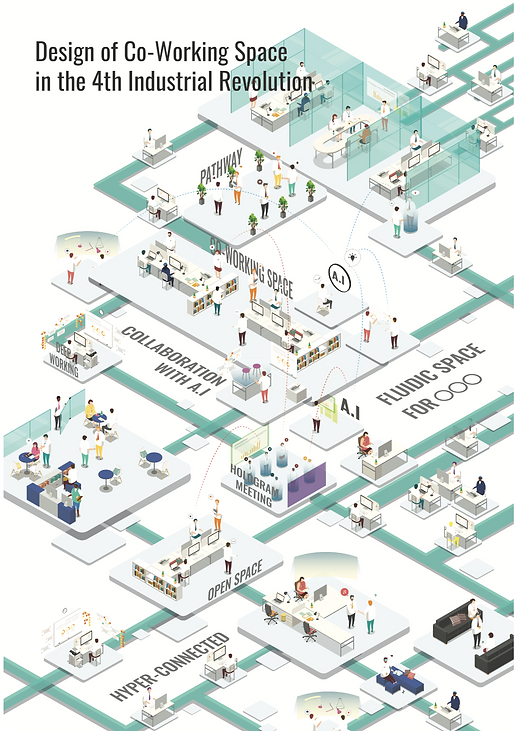Design of Co-Working Space in the 4th Industrial Revolution Era : Based on Literature Research and Creative Workshop

DESIGNER / YOUNGJÉ JEON
Humanity has reached the era of '4th Industrial Revolution' due to rapid technological innovation. In 2015, the topic of '4th Industrial Revolution' was put on the agenda in Davos Forum and has been a hot issue since then. If the previous three industrial revolutions were the development of individual technologies, this 4th industrial revolution is expected to bring about a much bigger wave with the gradual development of multiple technologies. The combination of Artificial Intelligence and Big Data, which is the core technology of the 4th Industrial Revolution, as noted by the historian Yuval Noah Harari, suggests that non-conscious algorithms based on pattern recognition are more important than human consciousness. As they do better, they see most of the work as a substitute for humans.
This study was conducted for the purpose of investigating the distinction and harmony between man and machine in the 4th industrial revolution era. In this regard, this study approached technological ethnology for in-depth analysis of human beings that cannot be solved by Artificial Intelligence and Big Data and focused on working space construction for human intuition and creativity. In addition, I carried out research on space that can cause innovation through the collaboration of human and super intelligent machine (artificial intelligence).
The direction of the future working space was presented through the preceding Literature Research and the Creative Workshop was held by recruiting participants from various fields to verify the directionality. After that, I classified and analyzed the derived insights according to their feasibility and organized the space composition for efficient collaboration between human and machine.
As a result, this study proposes a design book 'Future Space for Collaboration', suggesting a way to look at the collaboration between humans and machines, and a structure for collaborative working space that can lead to better innovation. Therefore, this study and the design book are meaningful in a way that they provide the basic guidelines of future working space design that will be proposed in the future.
현재 인류는 지금까지 아무도 내다보지 못할 정도의 기술혁신에 따른 ‘제 4차 산업혁명’ 시대를 맞고 있다. 2015년 다보스 포럼에서 4차 산업혁명을 대표 의제로 내세운 이후로, 이와 관련된 이슈는 계속해서 증가하고 있다. 앞선 세 차례의 산업혁명이 개별기술의 발전이었다면, 이번 4차 산업혁명은 복합기술의 단계적인 발전으로, 이전의 산업혁명보다 훨씬 큰 파장을 불러일으킬 것으로 전망되고 있다. 또한 4차 산업혁명의 중심 기술이라고 할 수 있는 인공지능과 빅 데이터의 결합은 역사학자 유발 하라리(Yuval Noah Harari)가 언급했듯이, 패턴 인식을 바탕으로 하는 비의식적 알고리즘이 인간의 의식보다 패턴 인식을 더 잘하게 됨에 따라 대부분 업무를 기계가 인간을 대체할 것으로 보고 있다.
본 연구에서는 이러한 4차 산업혁명의 흐름 속에서 인간과 기계와의 영역과 조화를 위한 고찰을 위해 진행되었다. 이에 있어서, 인공지능과 빅 데이터로는 해결하기 힘든 인간의 심층적 분석을 위해 기술 민족지학적으로 접근하였으며, 인간의 직관과 창의성의 발현을 위한 업무공간 구성에 대해 중점적으로 연구하였다. 이와 더불어 미래 초지능 기계(인공지능)와 인간과의 협업을 통해 혁신을 일으킬 수 있는 공간의 분할에 대한 연구를 진행하였다.
선행 문헌연구를 통해 미래 업무공간에 대한 방향성을 제시하였고, 그 방향성을 검증하기 위해 다양한 분야로 이루어진 참여자들을 모집하여 Creative Workshop을 진행하였다. 이후 도출된 인사이트를 실현 가능성에 따라 분류 및 분석하여 인간과 기계와의 효율적인 협업을 위한 공간 구성을 정리하였다.
이를 위해 본 연구에서는 디자인 북 ‘Future Space for Collaboration’을 제안하여, 인간과 기계와의 협업을 어떠한 방법으로 바라보아야 하고, 더 나은 혁신을 일으킬 수 있는 협업 업무 공간에 대한 구성을 제시하였다. 따라서 본 연구와 디자인 북은 향후 제안될 미래 업무공간 디자인의 기초적인 가이드라인을 제시하였다는 점에서 의의가 있다.



